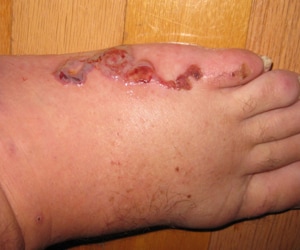Zoonotic Hookworm FAQs
On This Page
- What is animal (zoonotic) hookworm infection in people?
- What are the clinical manifestations of animal (zoonotic) hookworm in people?
- What should I do if I think I have hookworm infection?
- What is the treatment for animal hookworm infection?
- Can I get hookworm from my pet?
- How can I prevent animal hookworm infection?
What is animal (zoonotic) hookworm infection in people?
There are many different species of hookworms, some are human parasites and some are animal parasites. People can be infected by larvae of animal hookworms, usually dog and cat hookworms. The most common result of animal hookworm infection is a skin condition called cutaneous larva migrans.
What are the clinical manifestations of animal (zoonotic) hookworm in people?

Cutaneous larval migrans (CLM) in a person's foot. Courtesy Vince Conte, MD, Miami-Dade County Health Department
Most animal hookworm infections result in a skin condition called cutaneous larva migrans. People are infected when animal hookworm larvae penetrate the skin, causing a local reaction that is red and itchy. Raised, red tracks appear in the skin where the larvae have been and these tracks may move in the skin day to day, following the larvae’s movements. The symptoms of itching and pain can last several weeks before the larvae die and the reaction to the larvae resolves. In rare cases, certain types of animal hookworm may infect the intestine and cause abdominal pain, discomfort, and diarrhea.
What should I do if I think I have hookworm infection?
See your health care provider to discuss the possibility of infection and, if necessary, to be examined. There is no blood test for animal hookworm infection.
What is the treatment for animal hookworm infection?
The animal hookworm larvae that cause cutaneous larva migrans (CLM) usually do not survive more than 5 – 6 weeks in the human host. In most patients with CLM, the signs and symptoms resolve without medical treatment. However, treatment may help control symptoms and help prevent secondary bacterial infections. Antiparasitic treatments may be prescribed by your health care provider.
Can I get hookworm from my pet?
Yes, but not directly. Puppies and kittens are especially likely to have hookworm infections. Animals that are infected pass hookworm eggs in their stools. The eggs can hatch into larvae, and both eggs and larvae may be found in dirt where animals have been. People may become infected while walking barefoot or when exposed skin comes in contact with contaminated soil or sand. The larvae in the contaminated soil or sand will burrow into the skin and cause the skin to become irritated in that area. For example, this can happen if a child is walking barefoot or playing in an area where dogs or cats have been (especially puppies or kittens).
How can I prevent animal hookworm infection?
Wearing shoes and taking other protective measures to avoid skin contact with sand or soil will prevent infection with zoonotic hookworms. Travelers to tropical and subtropical climates, especially where beach exposures are likely, should be advised to wear shoes and use protective mats or other coverings to prevent direct skin contact with sand or soil.
Routine veterinary care of dogs and cats, including regular deworming, will reduce environmental contamination with zoonotic hookworm eggs and larvae. Prompt disposal of animal feces prevents eggs from hatching and contaminating soil — which makes it important for control of this parasitic infection.
This information is not meant to be used for self-diagnosis or as a substitute for consultation with a health care provider. If you have any questions about the parasites described above or think that you may have a parasitic infection, consult a health care provider.